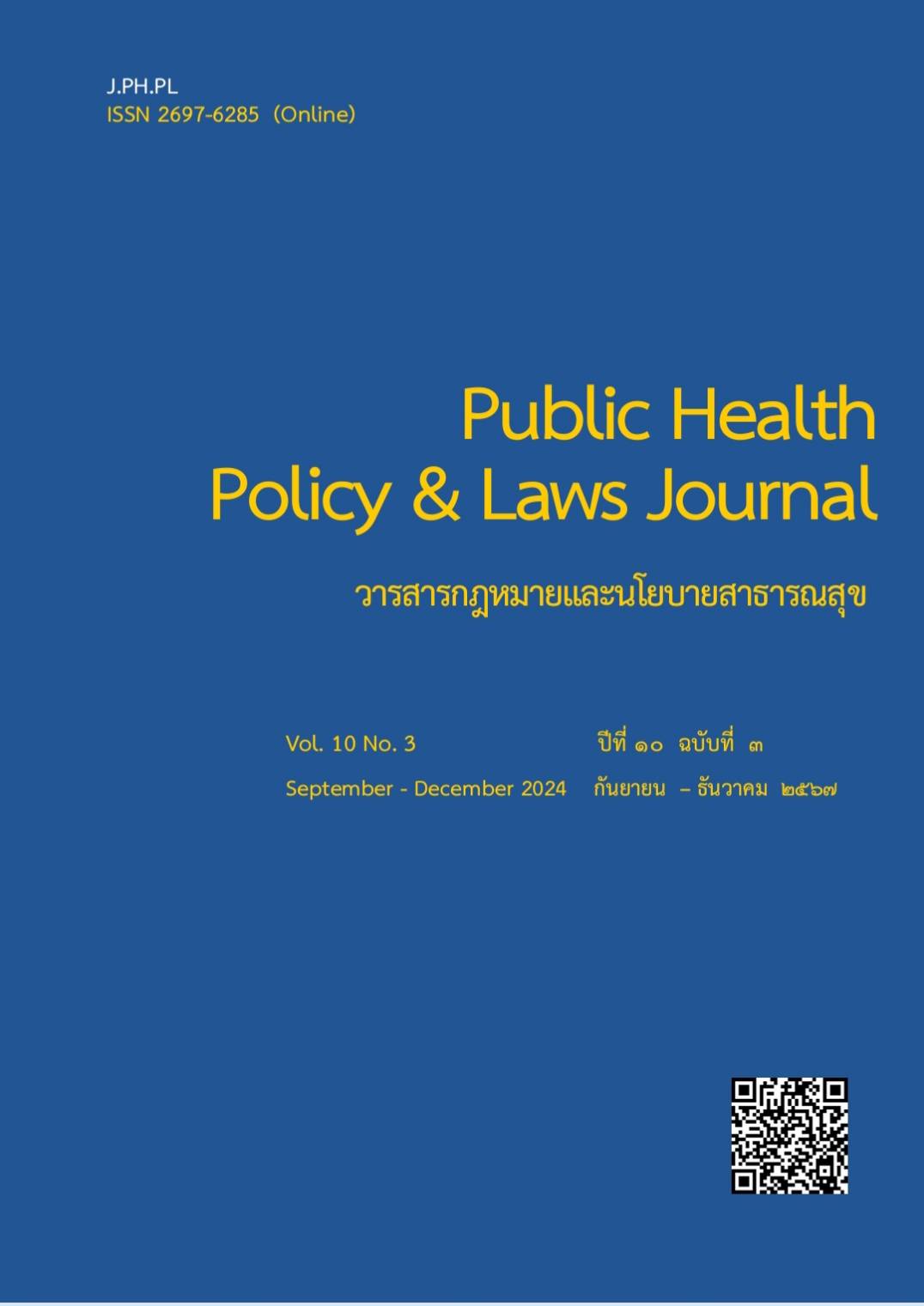Primary Health Care System Development According to Thailand's Health Policy
Keywords:
Primary health care Health policy Health promotionAbstract
The development of primary health care systems in Thailand is crucial in the context of health promotion and disease prevention, ensuring that the population has access to quality health services. This article aims to analyze the strategies and approaches used to develop the primary health care system according to Thailand's health policy framework. It examines significant health policies such as strengthening primary service units, developing community health care models, fostering community participation, and utilizing information technology for health data management. This study is based on an analysis of relevant research articles and case studies. The findings demonstrate that the effective development of primary health care systems enhances the capacity to meet the health needs of the population in a sustainable and efficient manner. Furthermore, it provides policy recommendations to help Thailand succeed in developing a quality and suitable health care system in the future.
References
Aree Cheevakasemsook. (2021). Digital technology for patient care: an essential for cardio-thoracic nurses in the 21stcentury. Thai Journal of Cardio-Thoracic Nursing, 32(1): 2-13.
Benjamaporn Pinyopornpanich, Chaiyaporn Suchatsoonthorn & Wllailuk Ruangrattanatrai. (2022). The National Public Health Reforms and the Challenges of Primary Care Service Systems. Dis Control J: 48(3): 667-679.
Chompunuch Supapvanich et all. (2022). Personal competency development among Public Health workers by Administrators of Regional Health Office 1 – 12. Thai Journal of Public Health and Health Sciences; TJPHS: 5(3): 138-153.
Department of Health Service Support. (2022). Primary health policy of Thailand. Retrieved from Department of Health Service Support.
Department of Health. (2018). Annual report on health and health. Retrieved from Department of Health.
Jirasak Pompha et all. (2022).The concept of public participation in community health promotion. PTU Journal of Science and Technology;2(2): 86-96.
Kumar, S., et al. (2018). Primary health care and its importance. Journal of Health Care for the Poor and Underserved, 29(2), 623-634.
Ministry of Public Health. (2021). Health@Home: Mobile health care system. Retrieved from https://www.moh.go.th.
Nawapron Wutthitham et all. (2021). The Roles of Nurse Practitioners in Health Promotion and Prevention for the Coronavirus Disease 2019 in Elderly Groups and Groups with Underlying Chronic Disease. Nursing News, Chiang Mai University, 49(1): 340-352.
Nantinaree Kongyuen. (2017). Primary health care system and development standards. Journal of Health Law and Public Health. 3(3):374-387.
Nutsford, D., et al. (2017). Health promotion and primary care: A partnership for health. Health & Place, 46, 1-3.
National Health Security Office. (2016). National health security fund administration guideline 2016. Bangkok. National Health Security Office.
Office of Policy and Strategy. (2016). Office of the Permanent Secretary, Ministry of Public Health. (Draft) Strategic Development Plan Primary Service Network (B.E. 2017-2026) supports the Constitution of the Kingdom of Thailand. Bangkok:Office of the Permanent Secretary, Ministry of Public Health. Office of Policy and Strategy.
Peters, D. H., et al. (2019). Improving health systems for universal health coverage. World Bank Publications.
Pondsathorn Pogpuemdee. (2016). Health at a Glance Thailand 2016. Nonthaburi: Ministry of Public Health.
Sirisawad, W., & Ratanaporn, N. (2021). Telehealth in Thailand: A path to enhance health access in rural areas. Journal of Telemedicine and Telecare, 27(1), 3-10. https://doi.org/10.1177/1357633X20935642
Schmitt A, Gahr A, Hermanns N, Kulzer B, Huber J, Haak T. (2013). The Diabetes Self-Management Questionnaire (DSMQ): development and evaluation of an instrument to assess diabetes self-care activities associated with glycaemic control.NCBI; 13(11):138. [cited 2017 November 1] from https://www.ncbi.nlm.nih.gov/pubmed
Suda Dejpitaksiriku et all. (2021). Effective Communication to Enhance Health Literacy in Diabetic Older Adults with High Blood Pressure. Nursing Journal of the Ministry of Public Health. 32(1): 1-13.
Thai Law. (2017). Constitution of the Kingdom of Thailand 2017. Bangkok: National Legislative Assembly.
Thai Health Promotion Foundation. (2563). Health Policy Framework for the 21st Century. Retrieved from Thai Health Promotion Foundation
Vichai Thianthaworn and Narong chaitiang.(2022). Role of operations in producing graduates in health sciences.In the next decade of the Praboromrajonani Institute, Journal of Public Health and Health Sciences. 5(1):236-246.
WHO. (2008) Primary health care: identified five key elements to achieving that goal;
[cited 2016November 23] Available from URL: http://www.who.int.
World Health Organization. (2021). Primary health care: Transforming vision into action. Retrieved from https://www.who.int/publications/i/item/9789241561949
World Health Organization. (2020). Telehealth: Opportunities and developments in Member States. Retrieved from https://www.who.int/publications/i/item/9789241517434
World Health Organization. (2018). Strengthening primary health care for universal health coverage. Retrieved from WHO reports
Downloads
Published
How to Cite
Issue
Section
License
Disclaimer and Copyright Notice
The content and information presented in articles published in the Journal of Law and Public Health Policy represent the opinions and sole responsibility of the respective authors. The editorial board does not necessarily agree with or assume any responsibility for the views expressed.
All articles, data, content, images, and other materials published in the Journal of Law and Public Health Policy are the intellectual property of the journal. Any individual or organization wishing to reproduce, distribute, or otherwise use the entirety or any part of such materials must provide proper citation.





